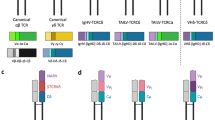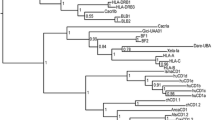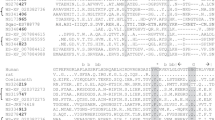Abstract.
The new antigen receptor (IgNAR) family has been detected in all elasmobranch species so far studied and has several intriguing structural and functional features. IgNAR protein, found in both transmembrane and secretory forms, is a dimer of heavy chains with no associated light chains, with each chain of the dimer having a single free and flexible V region. Four rearrangement events (among 1V, 3D, and 1J germline genes) generate an expressed NAR V gene, resulting in long and diverse CDR3 regions that contain cysteine residues. IgNAR mutation frequency is very high and "selected" mutations are found only in genes encoding the secreted form, suggesting that the primary repertoire is entirely CDR3-based. Here we further analyzed the two IgNAR types, "type 1" having one cysteine in CDR3 and "type 2" with an even number (two or four) of CDR3 cysteines, and discovered that placement of the disulfide bridges in the IgNAR V domain differentially influences the selection of mutations in CDR1 and CDR2. Ontogenetic analyses showed that IgNAR sequences from young animals were infrequently mutated, consistent with the paradigm that the shark immune system must become mature before high levels of mutation accompanied with selection can occur. Nevertheless, also in agreement with the idea that the IgNAR repertoire is entirely CDR3-based, but unlike studies in most other vertebrates, N-region diversity is present in expressed IgNAR clones at birth. During the investigation of this early IgNAR repertoire we serendipitously detected a third type of IgNAR gene that is expressed in all neonatal tissues; later in life its expression is perpetuated only in the epigonal organ, a tissue recently shown to be a (the?) primary lymphoid tissue in elasmobranchs. This "type 3" IgNAR gene still undergoes three rearrangement events (two D regions are "germline-joined"), yet CDR3 sequences were exactly of the same length and very similar sequence, suggesting that "type 3" CDR3s are selected early in ontogeny, perhaps by a self-ligand.
Similar content being viewed by others
Author information
Authors and Affiliations
Additional information
Electronic Publication
Rights and permissions
About this article
Cite this article
Diaz, M., Stanfield, R.L., Greenberg, A.S. et al. Structural analysis, selection, and ontogeny of the shark new antigen receptor (IgNAR): identification of a new locus preferentially expressed in early development. Immunogenetics 54, 501–512 (2002). https://doi.org/10.1007/s00251-002-0479-z
Received:
Revised:
Issue Date:
DOI: https://doi.org/10.1007/s00251-002-0479-z




